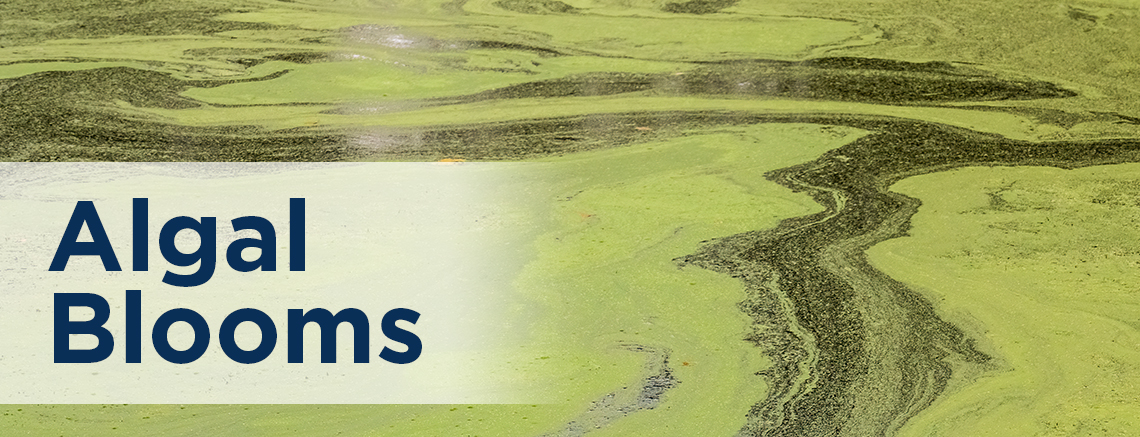

Algal Blooms

Algae often live in fresh bodies of water such as lakes, ponds and canals. Like plants, they can use the sun as an energy source. Small numbers of algae can explosively grow into large numbers very quickly – this rapid increase is called an algal bloom.
Conditions that can contribute to algal blooms include hot, dry weather and increased nutrients in a body of water. Sometimes an algal bloom can become harmful to people, pets, livestock, and aquatic plants and animals by producing toxins, shading light, and clogging gills in fish. It is hard to tell whether a bloom is harmful by just looking at it, so it is best to avoid water suspected of having an algal bloom. When in doubt, stay out!
Ciguatera fish poisoning, or ciguatera, is an illness caused by eating ocean fish that contain toxins produced by naturally occurring microscopic marine algae called Gambierdiscus toxicus.
People who have ciguatera poisoning may experience nausea, vomiting and neurologic symptoms, such as tingling fingers or toes. They also may experience temperature reversal sensation, so that cold things feel hot and hot things feel cold. Some fish commonly associated with ciguatera toxins include snapper, jacks, sea bass, grouper, triggerfish and barracuda. These large fish accumulate the toxins when they eat smaller fish that have been eating the toxic algae.
People who have ciguatera can be treated for their symptoms. However, ciguatera has no cure. Symptoms usually go away in days or weeks but can last for years.
Shellfish poisoning is a type of food poisoning people can get when they eat shellfish that have eaten toxin-producing algae. The 20 toxins responsible for paralytic shellfish poisonings (PSP) are all derivatives of saxitoxin produced by various species of algae including, but not limited to, Kerenia brevis, Alexandrium spp., Nitzchia, and Dinophysis. Paralytic Shellfish Poisoning (PSP), Diarrheic Shellfish Poisoning (DSP), Neurotoxic Shellfish Poisoning (NSP) and Amnesic Shellfish Poisoning (ASP) are the forms detected most frequently.
Eating contaminated shellfish results in a wide variety of symptoms, depending upon the toxins(s) present, their concentrations in the shellfish, and the amount of contaminated shellfish consumed.
In Paralytic Shellfish Poisoning (PSP), the effects are predominantly neurological and include tingling, burning, numbness, drowsiness, incoherent speech and respiratory paralysis, which requires prompt medical intervention.
Diarrheic Shellfish Poisoning (DSP) is usually a generally mild gastrointestinal disorder involving nausea, vomiting, diarrhea, and abdominal pain accompanied by chills, headache and fever.
Neurotoxic Shellfish Poisoning (NSP) causes both gastrointestinal and neurological symptoms, including tingling and numbness of lips, tongue and throat; muscular aches; dizziness; reversal of the sensations of hot and cold; diarrhea; and vomiting.
Amnesic Shellfish Poisoning (ASP) causes gastrointestinal disorders (vomiting, diarrhea, abdominal pain) and neurological problems (confusion, memory loss, disorientation, seizure or coma). Elderly people are most at risk from this type of shellfish poisoning.
Shellfish poisoning can be prevented by avoiding potentially contaminated bivalve (two-shell) mollusks. This is particularly important in areas during or shortly after "red tides." Travelers to developing countries should avoid eating all shellfish because they carry a high risk of viral and bacterial infections. Marine shellfish toxins cannot be destroyed by cooking or freezing.
For recreational activities in algae impacted waters the primary concern are exposures to cyanotoxins. These are produce by cyanobacteria which are also known as blue-green algae. Information for the most common cyanotoxins can be found below.
Although there are no documented reports of people getting sick from algal blooms in North Carolina, people should follow these practical precautions around algal blooms:
For additional information regarding how to protect your health in recreational waterbodies from other exposures visit here.
For additional information regarding how to protect your pet's health in recreational waterbodies please review the following fact sheet.
The North Carolina Department of Environmental Quality (NCDEQ) is responsible for monitoring and investigating reports of algal blooms across the state. NCDEQ has the ability to collect algal bloom samples to analyze them for algae that potentially pose a health risk. More information on how to report an algal bloom to NCDEQ is provided below.
How to identify an algal bloom (PDF)
To report an algal bloom, please contact your regional NCDEQ office.
If you have questions regarding health concerns related to algal blooms please contact the Occupational and Environmental Epidemiology Branch at (919)-707-5900.